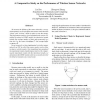Free Online Productivity Tools
i2Speak
i2Symbol
i2OCR
iTex2Img
iWeb2Print
iWeb2Shot
i2Type
iPdf2Split
iPdf2Merge
i2Bopomofo
i2Arabic
i2Style
i2Image
i2PDF
iLatex2Rtf
Sci2ools
122
click to vote
ACISICIS
2007
IEEE
2007
IEEE
A Comparative Study on the Performance of Wireless Sensor Networks
To increase the lifetime of the sensor networks, a recognized method is to switch off/on some sensor nodes between “sleep” and “activity” mode in order to save the energy. The performance metrics of an individual node can be calculated by using its DTMC model, the theoretical results include the average number of data units generated in a time slot λE, the sensor throughput T , the average buffer occupancy ¯B. In our research, we have implemented a wireless sensor network on NS2 in which the sensors nodes can be either in sleep or activity modes. Our simulations have produced the experiment results of performance metrics. By comparing the experiment results with the theoretical results, we demonstrate the DTMC model is able to accurately describe the behavior dynamics of a sensor node.
Related Content
| Added | 02 Jun 2010 |
| Updated | 02 Jun 2010 |
| Type | Conference |
| Year | 2007 |
| Where | ACISICIS |
| Authors | Lin Zou, Zhongwei Zhang |
Comments (0)

